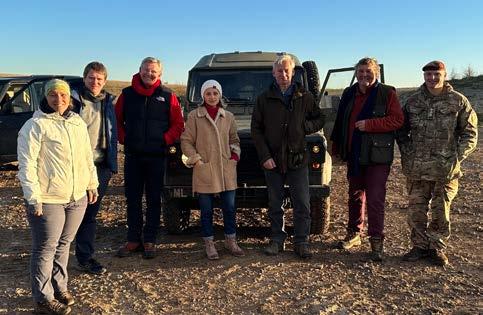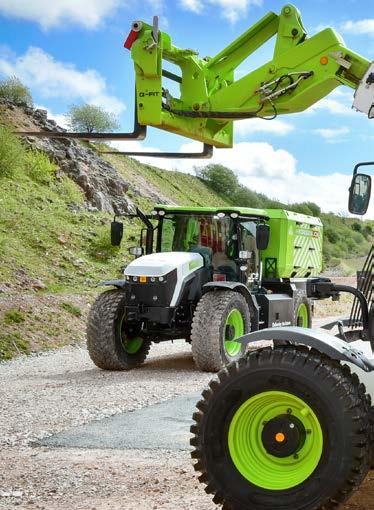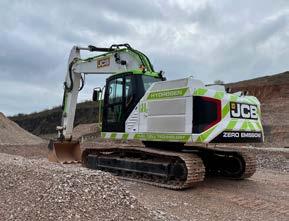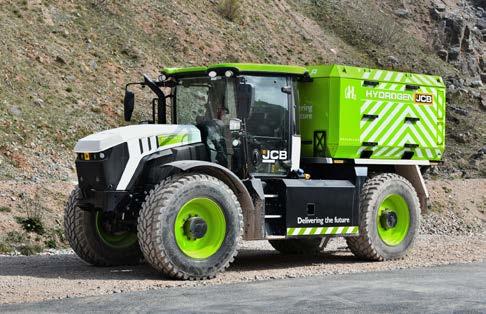
9 minute read
A Conflict of Interest
Secretary Alan Plom reports on the Trust’s recent involvement in a far-reaching international project:
In response to a request from the Royal Agricultural University (RAU), the Douglas Bomford Trust is supporting an environmental monitoring and remediation project in Ukraine, by sponsoring travel and equipment together with advice from our Chairman Nick August (a local farmer, user and consultant in cutting-edge technology associated with precision farming).
Advertisement
This research will help to alleviate the significant damage to large areas of productive agricultural land impacted (in more ways than one!) by extensive shelling and bombing, missiles and land mines spread around a country 2.5x the size of Great Britain. The damage to soil is obviously extensive and, not surprisingly, contamination is yet to be assessed.
RAU has worked closely with its ‘twinned’ academic institution in Ukraine – the Sumy National Agrarian University (SNAU) - to urgently develop remote sensing and soil chemistry sampling protocols, and to train Ukrainian non-combatants to identify soil pollution and collect pertinent data on which to base environmental remediation decisions.
RAU’s Statement on Ukraine
In response to the war in Ukraine, RAU vowed to “stand in solidarity with the people of Ukraine. As the ‘bread basket of Europe’, the people of Ukraine share the same passionate commitment as us to farming and to the land – they are our kith and kin in spirit.”
Following an initial virtual seminar between SNAU and RAU staff, and specialists from geospatial and environmental companies last year, the Trust funded Ukrainian Professor Olena Melnyk’s travel to the UK, to develop research protocols at RAU.
Whilst in the UK, she also held meetings in Westminster with DEFRA and the Foreign, Commonwealth and Development Office. RAU also gave a presentation to Lord Benyon and HALO (a global network of universities and start-ups enabling partnerships with industry).
Ground survey equipment
In addition to travel costs, the Trust has sponsored ground survey equipment (including drones and software) required for the pilot research on three impacted farms. The equipment and proposed

For further information, see the Trust’s website: www.dbt.org.uk or contact the Secretary Alan Plom via: enquiries@dbt.org.uk
You can also follow: on Twitter and on LinkedIn, for news of interesting events, opportunities, or developments. procedures, were trialled by the RAU/SUMY team on Salisbury Plain, helped by others from outside RAU, including Nicholas Mellor (interested in forensic archaeology and founder of a company exploring how the fusion of aerial surveys and advances in augmented reality can be used to protect endangered world heritage sites) and retired Rear Admiral Anthony Rix.
They were accompanied by our own ‘Action Man’, Trust Chair, Nick August. My vision of Nick and the research team dodging Challenger tanks appearing on the skyline was not far off, as the artillery trundled close by while the RAU Team were waiting for clearance to fly their drones!
This made #WorldSoilDay even more poignant for all involved. As Nick observed: “Imagine coming over from Ukraine and ending up on a military training ground with Challenger battle tanks, Apache helicopters and C17s flying overhead, Ukrainian and British forces charging around, while analysing soil in shell craters at 2C. Home from home!” Ukrainian people are wholeheartedly committed and made of strong stuff though, and we salute them too.
The first phase of this vital project will be completed with the data and samples collected being analysed in UK by RAU and ARUP Geospatial. RAU staff are giving their time and lab costs free of charge, as part of their contribution to the project.
Technical Road to net zero
The (off) road to zero emissions
In the frenzy of innovation around oil alternatives, one UK-based global manufacturer has developed a working hydrogen internal combustion engine from scratch. JCB recently invited a small group of journalists for a technology day to find out more. Andy Newbold went along.
In 2020 Lord Bamford, the company’s Chairman, laid down his ‘Chairman’s Challenge’ to the JCB engineering team to develop a fossil fuel free alternative to the diesel engine.
Going electric proved relatively easy for compact, lighter duty products, with the company bringing battery powered mini diggers, dumpers and a telehandler to market promptly. Although only about 5% of the tailpipe emissions of JCB products were accounted for with this group.

The company’s assumption was that the whole product range would be electrified in due course. In reality, issues of battery energy density and cost quickly crystallised.
The remaining 95% of JCB’s tailpipe emissions, lie with medium duty and heavy-duty products, think Loadalls, Fastracs and excavators.
No case for electric?
Comparable electric machines became considerably more expensive and heavy for equivalent power outputs.
Tim Burnhope, JCB’s Chief Innovation and Growth Officer presented an example of the implication of electrifying a 300hp Fastrac 8330. With a 16 hour duty cycle, typical of say a long day cultivating in autumn, an electric Fastrac would need approximately £400k of batteries to provide c1000kWh of power, its cost would increase 4.3x with an additional 10,000kg of weight. Clearly not an economic option.
The scenario played out in modelling to a greater or lesser extent across the mobile work equipment ranges.
The company’s customers, be it in the field or the building site, resoundingly wanted a diesel-like fuelled product, with comparable refuelling characteristics and an equivalent cost.

Hydrogen part 1
The company’s first step with hydrogen was to replace the diesel engine in a 20t excavator with a hydrogen fuel cell. The fuel cell works by passing hydrogen through a matrix to produce electricity, which is then stored in on-board batteries, or used to power electric motors.
Two prototypes were built, to assess cost and practicality. The transient response of a fuel cell is poor, ie how quickly the unit responds to the throttle, which directly impacts the useability of a fuel cell powered machine. Also, the hydrogen fuel cell excavator needed 2.7 times the cooling capacity of its diesel cousin. The prototypes were complicated, not robust and did not perform to the standard of diesel. Typically, a standard 20t excavator costs approx. £120k, the hydrogen fuel cell equivalents cost was north of £350k.
In summary, a lower performing, less reliable and more expensive alternative. Not what customers need.
The hydrogen engine
One kilogramme of hydrogen has the same energy density as three litres of diesel, but it comes in a gaseous form. The engine therefore has to have a gas-based fuelling and ignition system.
Fuel/air mixing with air has to occur before ignition, with the challenge of mixing higher density air with low density hydrogen to ensure a clean burn. The engine is fitted with a variable geometry turbo, to ensure a clean burn and efficient fuel/air mixing across the full rev range.
It’s a relatively low temperature ignition, and unlike diesel is a spark ignition process, with an engine compression ratio somewhere between that of petrol (at c 10:1) and diesel (20:1).
The development process started with a spark plug designed for a Le Mans car, which only lasted for 25 hours of operation. JCB has since worked with the supply chain to developed a custom spark plug, designed for a 1000 engine hour service interval.
In the automotive world, there are around 11 thousand hydrogen fuel cell powered cars produced annually, versus 7 million or so electric cars, having proven the point with the hydrogen fuel cell excavator, fuel cells were not the answer for JCB.

Don’t start from here
Sticking with the theme of hydrogen, next up was the hydrogen combustion engine. On paper, it’s an internal combustion engine, so the technology is familiar, with similar operational and maintenance characteristics to diesel.
Ryan Ballard, Engineering Director for JCB, explained the approach which led to the hydrogen engine. First, the company reviewed 76 existing technical projects and did a desk-based survey to draw some initial conclusions: Everyone else had converted a diesel or gasoline engine.
The hydrogen engine needed to be a ground-up, optimal solution, not a hydrogen fuel system just cobbled onto an existing engine. Hence JCB set about designing and developing a brand new hydrogen fuelled engine using a clean sheet of paper.
Steam and oil
The engine has zero tailpipe emissions, but does have 300oC steam coming out of the exhaust. This also can mix with the oil, so a specific hydrophobic oil was developed, to prevent oil and water mixing, and potentially impact reliability.
As an aside, due to the clean burn, on the dipstick inspected, the oil was clean and will remain clean throughout its service life.
Fuel storage and delivery
Hydrogen fuel does bring technical challenges outside of the engine, around storage and distribution. As it is gaseous, it needs to be stored at pressure. The tank on the machine (be it Loadall, Fastrac or excavator) is at about 350 Bar, with the mobile bowser running at 500 Bar. The law requires that vessels at these pressures require routine, third party safety inspections.
There is also the issue of immature hydrogen production and distribution networks, which will need to develop to support the new engines.
Production status
With a daily output in the UK of about 200 engines from JCB’s plant, and some commonality of parts, the company has the potential to ramp up hydrogen engine production rapidly.
Over 50 units have been made and are in testing, either on site in the company’s multi bay engine test facility or on the company’s farms and quarries. Field testing will be rolled out with key customers for real life duty cycle analysis throughout 2023.
A great step forward
Despite the arguments regarding the green source (or otherwise) of hydrogen as a fuel, JCB has ably demonstrated its ability to tackle a practical challenge and come up with a working zero tailpipe emissions engine in short order.

The finished engine drops straight into existing products to replace diesel, with an equivalent performance, cost and reliability to its diesel predecessors.
It is a credit to the vision and ingenuity of Lord Bamford and JCB’s engineers that this innovation has so swiftly come to fruition.
Potential goodbye to mined potash
Britain could break its reliance on imported, mined phosphate if a new application of a well-known scientific technique being tested at Harper Adams University proves successful.
“Electrocoagulation” is already used to remove heavy metals from water leaking from mine workings and landfills.
At HAU researchers have used the system to separate phosphate from slurry, and are now testing whether the phosphate is in a plant-available form.
Delegates at the Soil and Water Management Conference had a chance to visit the test unit at HAU’s dairy unit, where the trial work is being staged.
Reporting her own and predecessors’ work, Dr Marie Kirby said there is enough phosphate in the nation’s slurry to meet the whole arable sector’s needs.
HAU is now conducting crop trials to assess how available the phosphate is to plants. If it is, the UK would have its own source of phosphate and might not be dependent on imports.
Getting technical with slurry
Utilizing slurry was also discussed by Agrii’s Ian Rudge, who reported on his experience gained when working with Bedfordia Farms.
In that role he tried both umbilical spreading and Vredo machines to distribute thousands of tonnes of slurry and muck from the estate’s pig unit.
The slurry provides almost half the nitrogen needed by wheat and oilseeds, while also helping raise soil organic matter by 0.5-0.8% over 10-15 years.
Both systems have strengths and weaknesses, he reported.
The umbilical system uses the farm’s existing tractors and much lighter equipment, so it is cheaper and less likely to cause soil damage.
But the system can’t be used near water courses, on sloping land, or once crops reach a height where the trailing pipe would cause damage.
The contractor’s Vredo spreaders are bigger and heavier, creating more wheelings travelling back and forth to filling points.
But they can reach parts of the field that the umbilical system cannot, and – because they use tramlines – can work until crops are more fully grown.
Soil organic matter
Maintaining good levels of organic matter can help protect soil against extremes of both drought and flood, suggests Philippa Mansfield, Catchment Sensitive Farming lead for Natural England.
Whenever soil is lost it takes a lot of expensive and valuable nutrients, she adds:
“As organic matter levels rise the soil’s ability to store water rises, which is very important in a drought year.
“And in a wet year it could hold more water in the upper catchment, which could help reduce flooding downstream.”
A more diverse landscape
Encouraging a more diverse landscape could help improve, crop yields suggests Chloe MacLaren from Rothamsted Research.
Talking to the Soil and Water Management Centre’s conference, she said there need not be a pay-off between efficient production and enhancing the environment.
And a creative approach to poor yielding parts of any field might help the productivity of the better parts.
Putting awkward corners and margins into wildlife habitats might reduce field size a little, she admits.
But if those habitats become home to pollinators and species that prey on pests then they can help raise yields on the remaining land.



